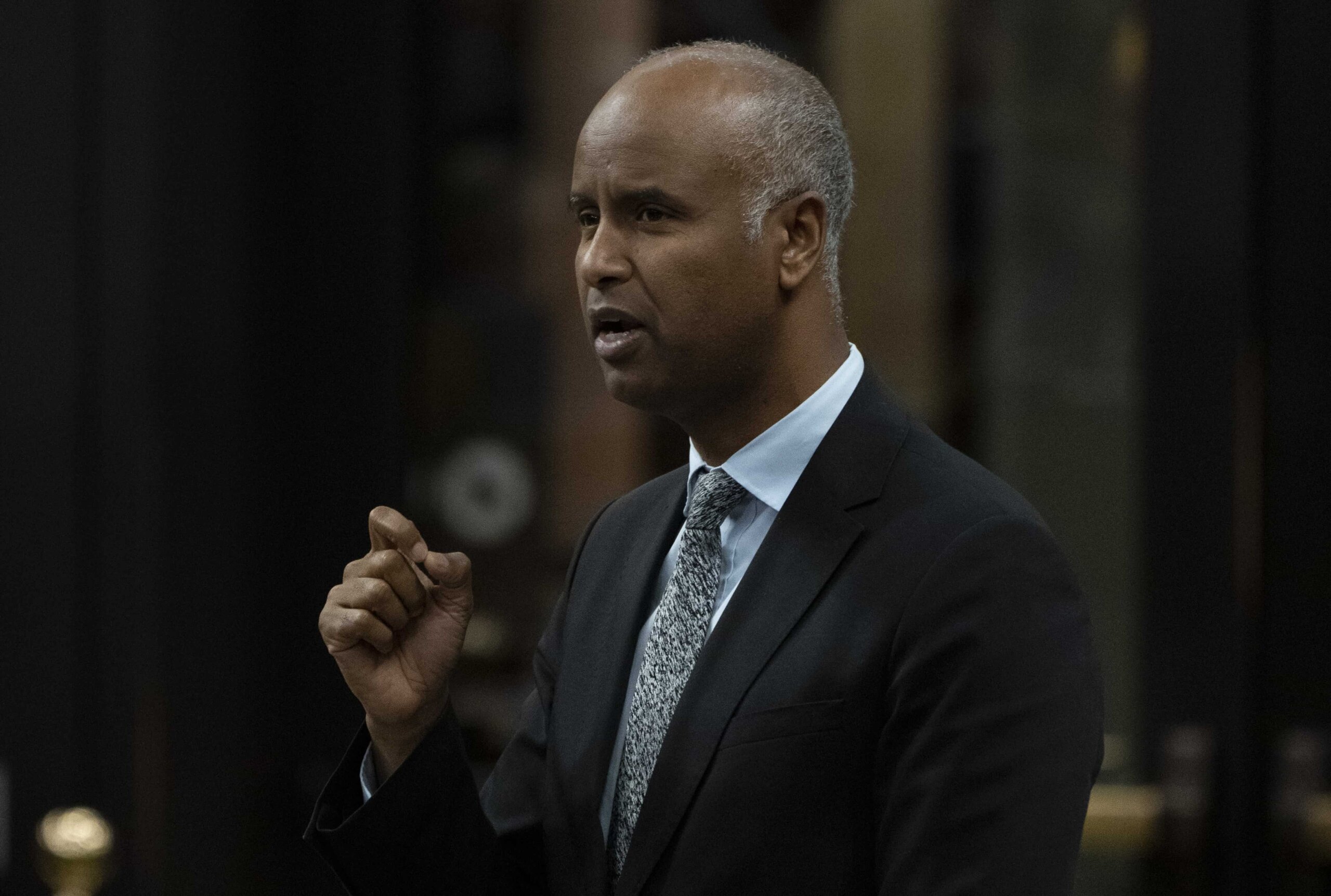According to the current research from the Canadian Mortgage and Housing Corporation , LGBTQ2S+ people in Canada have particular concerns when it comes to housing, whether it is finding safe, suitable and affordable places to call home in an inclusive community, or where there is access to social or medical services. Queer and trans youth make up anywhere between 10 and 40 percent of homeless youth in Canada; queer and trans seniors worry about needing to go back into the closet in order to get appropriate care.
The federal government says they have a plan to help, and have carved out specific programming for the LGBTQ2S+ communities. Minister of Housing and Diversity and Inclusion Ahmed Hussen’s office reached out to talk about these programs, to ensure that the community is aware that they exist, but it took him some time to get warmed up to the topic of conversation when we did get to talking. Even though his office approached me to talk about programs, Hussen still led off the conversation by praising the government’s two affordability measures bills being debated in the House of Commons before we could finally get into talking about how the National Housing Strategy helps queer and trans people in Canada.
The National Housing Strategy launched in 2017 and aims to invest more than $72 billion over ten years, which is a major re-engagement on the federal housing file since the Chrétien government largely abandoned it in the budget cuts of the mid-1990s.
“From the very beginning, LGBTQ2S+ Canadians were prioritized as part of that National Housing Strategy,” Hussen says. “We understand that LGBTQ2S+ Canadians have higher housing needs than the average population.”
Hussen says this was complemented by the establishment of the 2SLGBTQI+ Secretariat that was also established in 2017, and the recent allocation of $100 million to support the recently announced federal Action Plan.
“Our government understands that housing programs do consider vulnerable populations, including LGBTQ2S+ population,” Hussen says. “When you look at programs like Reaching Home, which is the federal anti-homelessness program, we have made sure that some of those investments—which we’ve recently doubled—tackle homelessness among different members of the LGBTQ2S+ community.”
Hussen also points to the pandemic-oriented Rapid Housing Initiative, which has created 10,200 affordable housing units since its inception, as also having prioritized LGBTQ2S+ housing projects, as well as the National Housing Co-Investment Fund, which is also targeted at“deeply affordable” housing, shelters and transitional housing.
“An example of a project that got support from our housing programs … is the transitional housing for Toronto LGBTQ2S+ youth in 2019,” Hussein says. “Through this co-investment fund, the federal government gave $4.3 million for the construction of the EGALE Centre, which is to provide 26 transitional and five emergency housing units for LGBTQ2S+ youth in Toronto who are at risk of becoming homeless or who are already on the street.”
Hussen also notes that there is funding available for other youth who are on the street because of stigma and discrimination against them, and services through nonprofits across the country for other members of the queer and trans communities who find themselves at risk of homelessness. This includes shelters, transitional housing, rental supports or capacity-building for organizations to ensure that they have that lens when it comes to providing housing.
When it comes to the statistics on the size of the housing needs of queer and trans communities, I asked whether it’s available given that this government has had a problem with data collection. Hussen says that there isn’t a shortage of data, but the problem has been putting it together as it is frequently collected in different ways. He notes that he recently met with Statistics Canada about how they are doing this, but the message he received was that they need more funding in order to expand their capacity to do a comprehensive job in putting that data together.
“For any new programming in the National Housing Strategy, I have insisted on a reflection on the fact that the investments have to reflect the approximate need in the community,” Hussen says. “When I was approving the Rapid Housing Initiative, I was ensuring that I got data on the deployment of those funds, and which organizations and which projects were funded, and I’m happy to report to you that a significant number of those projects have and continue to prioritize LGBTQ2S+ people, in addition to other vulnerable groups.”
Hussen says it has been an educational experience to go to funding announcements and see how the units are allocated. Hussen cites an example of a project with 56 units of affordable housing, six or 12 of them would go to Indigenous people, another dozen to LGBTQ2S+ people, with the remaining units going to women and children fleeing domestic violence, vulnerable seniors and people with disabilities.
“You could see the breakdown in numbers, and we had asked proponents to do this to prioritize the local vulnerable population, and not only did they have to build it in twelve months or less, but those people had to reflect the needs on the ground,” Hussen says. “I’m happy to say that with the Rapid Housing Initiative, the numbers have been very encouraging with the deployment of the money, and the actual homes for people to live in.”
Hussen says it has been harder for rural proponents to meet the needs of vulnerable groups, and he plans to work more closely with the minister of Rural Economic Development to ensure that the programs work better than currently.
Going forward, the government is working to deploy the $4 billion Housing Accelerator Fund promised during the election, which aims to help municipalities transform their processes and policies to prioritize increasing the housing supply across the country.
“Normally federal programs for housing are provided to nonprofits to build housing,” Hussen says. “This is different. We are looking at things from the system side of things, and the idea is to incentivize the adoption of progressive housing policies such as inclusionary zoning, building around transit, densification and affordable housing. I believe this will make a difference to all vulnerable groups that experience homelessness at a higher rate than the general population, including LGBTQ2S+ Canadians.”
Hussen says it’s his job to make sure that organizations representing marginalized communities, including the queer and trans communities, are aware of the federal funds available so that they can bring forward their projects that they may not realize federal funding is available for.
“There is significantly more money being invested in affordable housing, and we want people to know that so they can access these programs,” Hussen says.
When his assistant breaks in to say that it’s the last question, I note that I would be remiss if I didn’t ask about the Laith Marouf situation, where Marouf and his company were given federal funds for “anti-racism training,” while also spouting antisemitism over social media, and what Hussen is doing in his role as minister for Diversity and Inclusion to ensure that this kind of funding doesn’t happen again.
Hussen starts by unequivocally condemning Marouf’s actions, and says that what ultimately happened was a failure in the vetting process.
“We cut funding for this organization, suspended their project and are in the process of making sure that we review and improve the Department of Canadian Heritage’s vetting protocol so that this absolutely never happens again,” Hussen says. “We are introducing enhanced vetting training for all program officers to ensure that multiple individuals review each application accordingly before any funding is approved.”
Hussen adds that they have dramatically improved the eligibility conditions that allow the federal government to take immediate action if anyone who has received federal funds is found to be promoting or sharing hate, racism, discrimination, homophobia or intolerance of any kind.
“All organizations and individuals who see their funding cut as a result of this behaviour will not only be ineligible for future funding from this program, they will be ineligible for any program funding under the Department of Canadian Heritage,” Hussen says. “No single dollar will be rolling out until these new measures are put into place, and we’ll continue to take these really strong, appropriate steps to ensure there is proper vetting and enhanced due diligence to ensure this happens ever again, and in the unlikely event that it does, we’ll be able to move much faster to cut funding.”


 Why you can trust Xtra
Why you can trust Xtra


